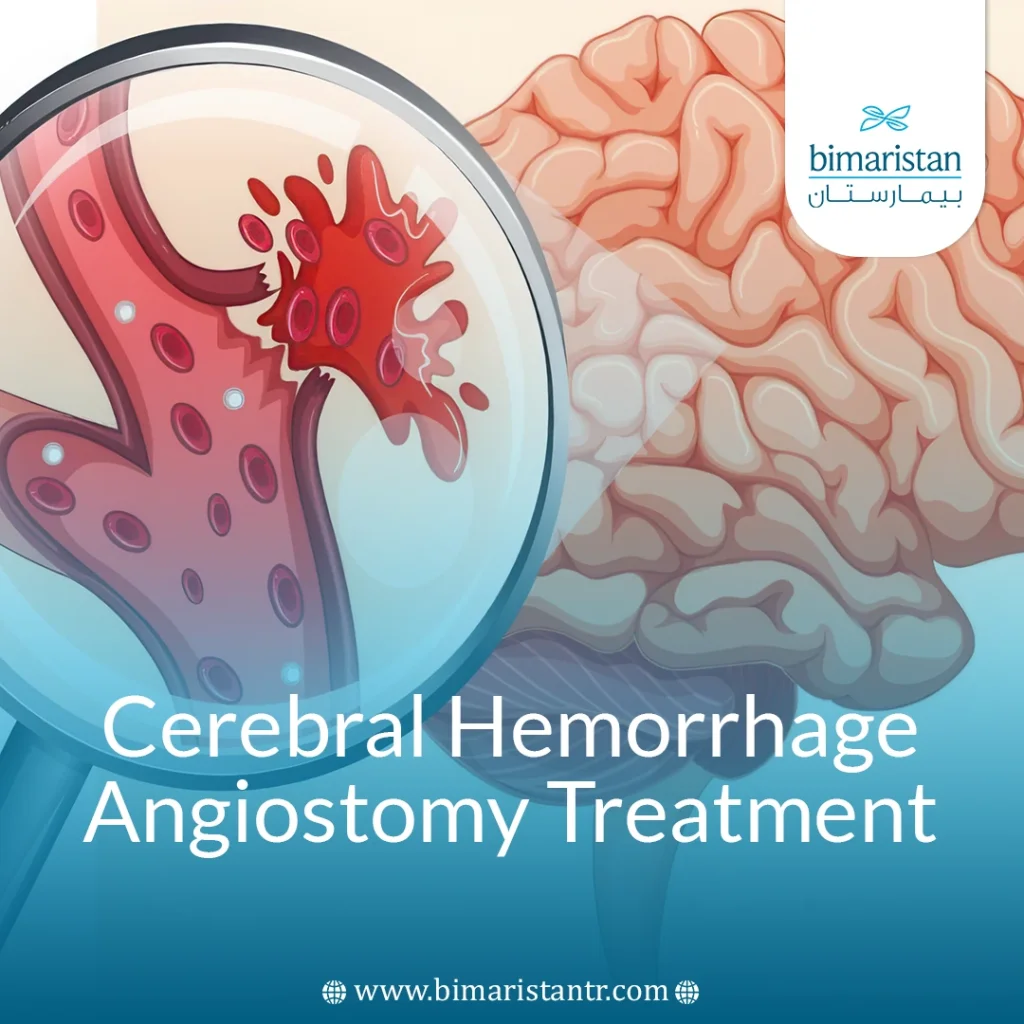Cerebral hemorrhage angiostomy treatment is an advanced solution that enables the management of critical cases with high precision and minimal surgical intervention. Studies show that this approach can reduce bleeding complications by up to 40% and significantly enhance recovery outcomes. With ongoing advancements in medical technology, this treatment option is delivering promising results for a large percentage of patients facing these life-threatening conditions.
What is a cerebral hemorrhage?
One of the blood vessels supplying the brain ruptures, causing blood to escape outside the vessels and accumulate between the brain and its surrounding membranes or, in some cases, between the membranes and the skull. In certain situations, the bleeding may occur within the brain tissue itself. This is often triggered by cerebrovascular disease, such as aneurysms or arteriovenous malformations, and may also result from trauma or elevated intracranial pressure. The outcome is a disruption in cerebral blood perfusion, and if this interruption exceeds six minutes, brain tissue begins to die and lose function. Cerebral hemorrhage angiostomy treatment offers a targeted intervention to restore circulation and minimize irreversible damage.

What is a cerebral hemorrhage angiostomy treatment?
It is a surgical procedure that involves creating a small opening or hole in the wall of a vessel, whether an artery or a vein and then inserting a catheter into the bloodstream to reach specific locations. This procedure enables doctors to perform various medical procedures that require access to the bloodstream, such as opening a drainage pathway in cases of intraventricular hemorrhage or cerebrospinal fluid from the ventricles.
When to treat cerebral hemorrhage with angiostomy?
Cerebral hemorrhage angiostomy treatment is used to access the brain vessels through an arterial catheter to close a ruptured aneurysm, or to inject substances to plug abnormalities in the vessel wall that cause bleeding. Cerebral hemorrhage angiostomy treatment is considered the most appropriate option for certain conditions, including:
- Increased intracranial pressure: A vascular anastomosis drains blood or cerebrospinal fluid.
- Obstruction of the ventricles (hydrocephalus): An angioplasty catheter is inserted to resolve the issue.
- Neurological deterioration: An angiostomy is used to insert an imaging tool to find the cause of the deterioration.
Cerebral hemorrhage angiostomy treatment Steps
First, imaging is performed to identify the precise location and cause of the bleeding, using advanced techniques such as computed tomography (CT) or magnetic resonance imaging (MRI). The patient is then transferred to the operating room, where both the patient and the insertion site, typically the skull, are prepared for surgery. In most cases, local anesthesia is administered. As part of the cerebral hemorrhage angiostomy treatment, a catheter is guided toward the ventricle to drain accumulated blood or cerebrospinal fluid. Throughout the procedure, intracranial pressure and radiographic imaging are continuously monitored to assess the effectiveness of the treatment.
Potential benefits and risks of an angiostomy
Like any surgical procedure, the treatment of cerebral hemorrhage through angiostomy has several benefits and risks. The primary benefits include reducing pressure on the brain and potentially saving the patient’s life in emergency situations. There are several risks associated with this procedure, including the possibility of nervous system infection, secondary bleeding, or damage to brain tissue. Therefore, it is essential to have the procedure performed at a reputable medical center, and the brain surgeon must have prior experience in conducting such operations.
Recovery after cerebral hemorrhage angiostomy treatment
After cerebral hemorrhage angiostomy treatment, the patient is referred to the intensive care unit (ICU), where he is closely monitored around the clock. If bleeding, discharge from the wound site, seizures, a change in level of consciousness, sudden onset of fever, or a temperature above 38 degrees is observed, the patient’s companions should immediately inform healthcare providers.
Comparing angiostomy with other treatments in the case of cerebral hemorrhage
There are several methods for draining a cerebral hemorrhage that serve as alternatives to angiostomy, including open surgery and conservative treatment. The key differences among these methods are:
- Surgical intervention: Minimally invasive in angiostomy, major surgery in open surgery as it requires skull opening, and no surgical intervention in conservative treatment.
- Bleeding volume: Angiostomy is appropriate for moderate to minor hemorrhages; open surgery is reserved for extensive or superficial bleeding, whereas conservative treatment is limited to minor cases.
- Risks: Open surgery carries the highest risk, including infection or damage to brain tissue, while angiostomy presents moderate risks such as thrombosis, closure failure, or infection. Conservative treatment has the lowest risk, mainly the potential for hemorrhage progression.
- Cost: High for angioplasty, very high for open surgery, and low for conservative treatment.
Is angiostomy a definitive treatment for cerebral hemorrhage?
Cerebral hemorrhage angiostomy treatment is not a definitive solution for all types of bleeding, as it may serve as a temporary or ambulatory intervention in certain cases, such as subarachnoid hemorrhage from a large aneurysm, traumatic bleeding with vascular rupture, or hemorrhage in patients on anticoagulants. However, some conditions require subsequent complementary surgery, including large or complex aneurysms, extensive arteriovenous malformations, or bleeding associated with significant thrombosis. Early and comprehensive rehabilitation following cerebral hemorrhage angiostomy treatment is a vital component in enhancing recovery outcomes and improving the patient’s quality of life.
Cerebral hemorrhage angiostomy treatment is a precise and effective option for managing critical cases, combining minimally invasive techniques with promising clinical outcomes. Bimarestan Medical Center offers this advanced treatment utilizing state-of-the-art technology and a highly experienced medical team, with the goal of minimizing complications and achieving optimal results for patients.
Sources:
- American Stroke Association. (2023). Treatment options for intracerebral hemorrhage.
- National Institute of Neurological Disorders and Stroke. (2022). Cerebral hemorrhage. U.S. Department of Health & Human Services.

